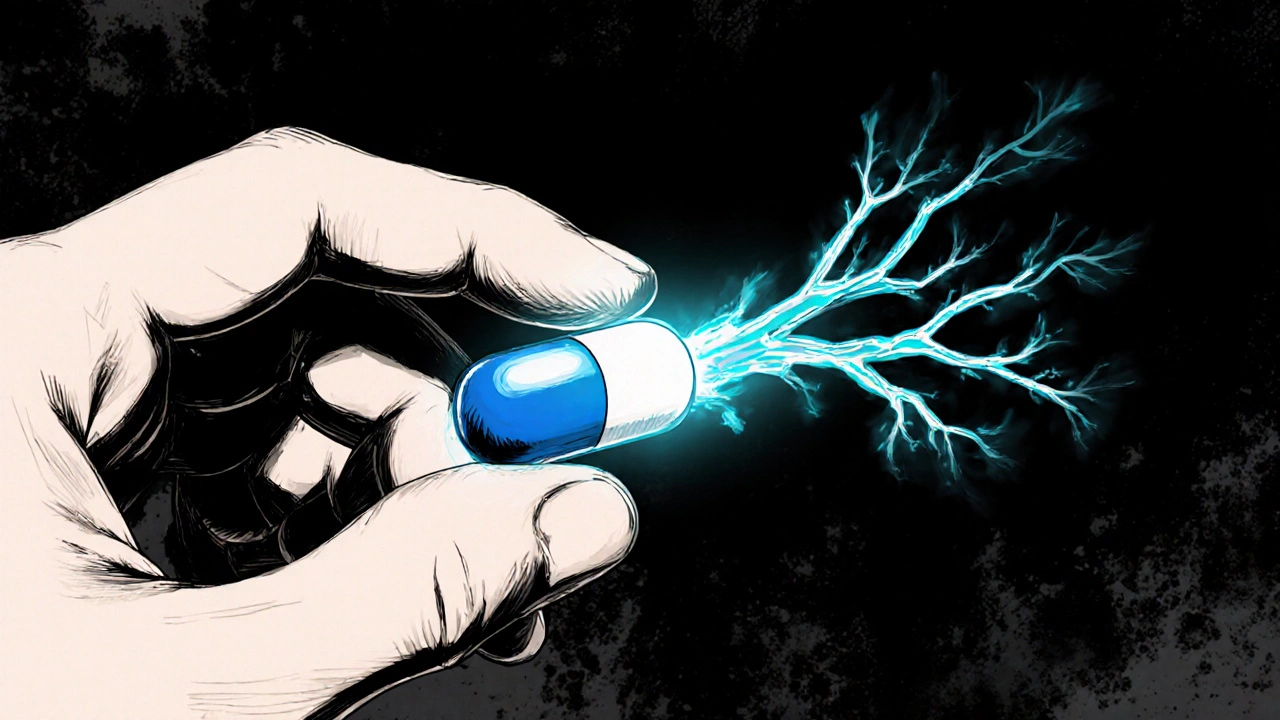Adalat (Nifedipine) vs Alternatives: Full Comparison Guide

Hypertension Medication Comparison Tool
Medication Selection
Select a medication to see key attributes
Key Attributes
Quick Takeaways
- Adalat (nifedipine) is a short‑acting calcium‑channel blocker mainly used for hypertension and angina.
- Long‑acting CCBs such as amlodipine offer smoother blood‑pressure control with once‑daily dosing.
- Non‑CCB options like labetalol combine alpha‑ and beta‑blocking effects and work well for pregnancy‑related hypertension.
- Cost, dosing frequency, and side‑effect profile are the three biggest decision factors.
- Talk to your doctor about personal risk factors before switching.
When you search for "Adalat alternatives" you probably want to know whether another pill can do the same job with fewer side effects, a better price, or a simpler schedule. This guide breaks down the most common substitutes, compares them side‑by‑side, and gives you a clear checklist to decide which drug fits your health profile.
What is Adalat (Nifedipine)?
Adalat is a brand name for nifedipine, a dihydropyridine calcium‑channel blocker that relaxes vascular smooth muscle, lowering peripheral resistance and blood pressure. It comes in immediate‑release (IR) and extended‑release (ER) formulations. The IR form is often prescribed for acute angina episodes, while the ER version manages chronic hypertension.
Key attributes of nifedipine:
- Mechanism: inhibits L‑type calcium channels in arterial smooth muscle.
- Typical dose: 10‑30 mg IR 3‑4 times daily or 30‑60 mg ER once daily.
- Onset: 15-30 minutes (IR), 1‑2 hours (ER).
- Common side effects: flushing, headache, peripheral edema.
Major Alternatives to Consider
Below are the five drugs that most physicians turn to when they need a substitute for nifedipine. Each belongs to a slightly different pharmacological class, which influences how it works and who benefits most.
Amlodipine is a long‑acting dihydropyridine calcium‑channel blocker with a half‑life of about 35 hours, allowing once‑daily dosing.
Diltiazem is a non‑dihydropyridine calcium‑channel blocker that also reduces heart rate, making it useful for certain arrhythmias.
Verapamil is another non‑dihydropyridine CCB, stronger on the cardiac conduction system and often chosen for migraines.
Labetalol combines alpha‑ and beta‑blocking activity, providing dual‑mechanism blood‑pressure reduction, especially safe in pregnancy.
Hydralazine is a direct arteriolar vasodilator that works upstream of calcium channels, traditionally used in hypertensive emergencies.
How the Alternatives Stack Up
| Drug | Class | Typical Dose | Key Indications | Major Side Effects | Cost (US $/month) |
|---|---|---|---|---|---|
| Nifedipine (Adalat) | Short‑acting dihydropyridine CCB | 10‑30 mg IR 3‑4×/day or 30‑60 mg ER daily | Hypertension, Angina | Flushing, headache, edema | ≈ $12 |
| Amlodipine | Long‑acting dihydropyridine CCB | 5‑10 mg once daily | Hypertension, Stable angina | Peripheral edema, dizziness | ≈ $8 |
| Diltiazem | Non‑dihydropyridine CCB | 120‑360 mg once daily (ER) | Hypertension, Atrial fibrillation | Bradycardia, constipation | ≈ $15 |
| Verapamil | Non‑dihydropyridine CCB | 80‑240 mg once daily (ER) | Hypertension, Migraine prophylaxis | Constipation, AV block | ≈ $18 |
| Labetalol | Mixed α/β‑blocker | 100‑400 mg twice daily | Hypertension (incl. pregnancy) | Fatigue, orthostatic hypotension | ≈ $10 |
| Hydralazine | Direct arteriolar vasodilator | 25‑100 mg three times daily | Hypertensive emergencies, Preeclampsia | Reflex tachycardia, lupus‑like syndrome | ≈ $7 |

Decision‑Making Checklist
Use this short list to see which drug aligns best with your situation.
- Dosing convenience: If you hate taking pills multiple times a day, favor amlodipine (once‑daily) or labetalol.
- Heart‑rate concerns: Diltiazem and verapamil slow the heart-good for arrhythmias but risky if you already have bradycardia.
- Pregnancy: Labetalol is the preferred antihypertensive; nifedipine is acceptable but used cautiously.
- Cost sensitivity: Hydralazine and generic nifedipine are the cheapest; verapamil tends to be pricier.
- Side‑effect tolerance: If peripheral edema bothers you, switch to diltiazem or labetalol, which have lower edema rates.
When to Stick with Adalat
Even with many alternatives, Adalat remains a solid choice in specific scenarios:
- Acute angina attacks: The rapid onset of IR nifedipine can abort chest pain faster than most long‑acting agents.
- Patients already controlled on nifedipine: Switching can destabilize blood‑pressure control and trigger side‑effects.
- Renal impairment: Nifedipine is largely metabolized by the liver, making it safer than some β‑blockers that need dose adjustment.
Potential Pitfalls and How to Avoid Them
Switching antihypertensives isn’t just a “swap the pill” move. Here are common mistakes and safeguards:
- Missing the wash‑out period: Some CCBs (especially immediate‑release nifedipine) should be tapered to prevent rebound hypertension.
- Ignoring drug interactions: Verapamil and diltiazem inhibit CYP3A4; they can raise levels of statins, leading to muscle toxicity.
- Under‑dosing the new agent: If you move from a 60 mg ER nifedipine to amlodipine, start at 5 mg and titrate up; jumping straight to 10 mg may cause hypotension.

Real‑World Example
Mark, a 58‑year‑old with hypertension and mild peripheral artery disease, was on Adalat 30 mg ER daily. He complained of persistent ankle swelling. His doctor switched him to amlodipine 5 mg daily and added a low‑dose thiazide diuretic. Within two weeks, Mark’s blood pressure stayed in the 120s/70s, and the edema resolved. The change worked because amlodipine’s longer half‑life gave steady control without the peak‑related vasodilation that triggers swelling.
Bottom Line
Choosing a blood‑pressure pill isn’t one‑size‑fits‑all. Adalat (nifedipine) shines for rapid angina relief and patients who respond well to short‑acting CCBs. Alternatives like amlodipine, diltiazem, verapamil, labetalol, and hydralazine each bring unique strengths-whether it’s once‑daily dosing, heart‑rate modulation, pregnancy safety, or lower cost.
Talk to your healthcare provider, compare the key attributes above, and consider your lifestyle, comorbidities, and budget. The right choice can keep your blood pressure in range with minimal hassle.
Frequently Asked Questions
Can I take Adalat with other blood‑pressure drugs?
Yes, doctors often combine nifedipine with a diuretic or ACE inhibitor for stronger control, but they watch for additive hypotension and edema.
Is amlodipine safer than nifedipine for older adults?
Amlodipine’s gradual onset reduces the risk of sudden drops in blood pressure, making it a common choice for seniors, especially when they have balance issues.
What should I do if I experience severe headache after taking Adalat?
Contact your doctor right away. Headaches can signal overly rapid vasodilation, and the dose might need adjustment or a switch to a slower‑release formulation.
Can I use nifedipine during pregnancy?
It’s classified as Category C. Some obstetricians prescribe it for severe hypertension when benefits outweigh risks, but labetalol or methyldopa are generally preferred.
How does cost compare across these alternatives?
Generic nifedipine and hydralazine are usually under $10 per month, amlodipine sits around $8‑$12, while verapamil and diltiazem can reach $15‑$20. Insurance coverage varies, so check your formulary.



Ed Mahoney
Oh great, another pill showdown, because we all love endless med swaps.
Brian Klepacki
If you ever dreamed of a soap‑opera drama unfolding in your pharmacy cabinet, behold the saga of Adalat versus its rivals.
First, imagine the thunderous entrance of amlodipine, strutting in once‑daily fashion like a celebrity on a red carpet, demanding applause for its smooth blood‑pressure tango.
Then enter diltiazem, the brooding anti‑hero, whispering sweet nothings to your heart rate, promising to slow the chaotic rhythm of atrial fibrillation.
Verapamil follows, a dark knight clad in constipation‑laden armor, ready to duel any errant AV block that dares cross its path.
Labetalol bursts onto the scene, a double‑agent mixing alpha and beta tricks, stealing the spotlight in pregnancy‑related battles.
Hydralazine, the wild card, swoops in with a reflex tachycardia flare, a daredevil used only when the blood pressure emergency sirens wail.
Each contender brings its own chorus of side‑effects, a symphony ranging from peripheral edema to lupus‑like syndromes, leaving clinicians to conduct a perilous orchestra.
The cost battle rages like a price‑war arena, with generic nifedipine and hydralazine striking cheap blows, while verapamil and diltiazem swing higher‑priced daggers.
Yet, beyond numbers and mechanisms, the true drama unfolds in the patient’s daily life: the nightmare of multiple daily doses versus the sweet lullaby of once‑daily convenience.
Imagine the patient, weary from juggling pills, yearning for the simplicity of a single capsule that doesn’t scream at midnight.
In the meantime, the titration tango demands careful steps; a reckless jump from 60 mg ER nifedipine to 10 mg amlodipine can plunge the patient into hypotensive oblivion.
Drug interactions add another layer of intrigue, as verapamil and diltiazem sneakily inhibit CYP3A4, raising statin levels into the realm of muscle toxicity.
And let us not forget the wash‑out ritual, a ceremonial taper to prevent the dreaded rebound hypertension that haunts the night.
Ultimately, the choice is less a verdict and more an evolving narrative, tailored to each protagonist’s comorbidities, budget, and lifestyle.
So choose your hero wisely, for the plot thickens with every prescription.
Shermaine Davis
That checklist really helps to match the right med with the right person.
Sometimes I forget how much dosing frequency matters for folks with busy schedules.
The edema note is a lifesaver; I’ve seen patients stop their meds because of swelling.
Also, the pregnancy tip about labetalol is spot on for my sister‑in‑law.
Thanks for making the comparison so clear!
Selina M
Loving the side‑by‑side table – it makes the differences crystal clear.
Once‑daily options really do simplify life.
Good job breaking it down.
tatiana anadrade paguay
The cost breakdown is super helpful, especially when insurance is tricky.
Seeing hydralazine under $10 a month is a nice surprise.
Overall a very practical guide.
Nicholai Battistino
I agree with the point about once‑daily dosing reducing missed pills.
It's a simple yet effective way to improve adherence.
Suraj 1120
Honestly, all this “once‑daily” hype is just pharma marketing fluff.
If you can’t handle three pills a day, you’re not trying hard enough.
Shirley Slaughter
The drama of switching meds is real – I’ve watched patients go from triumph to despair in weeks.
It’s a roller‑coaster of blood pressure readings and side‑effects.
Staying informed can turn that ride into a smooth glide.
Sean Thomas
Did you know the pharma companies are secretly testing these drugs on hidden populations?
It’s why you see weird side‑effects pop up out of nowhere.
Aimee White
Oh, the conspiracy vibes are strong with this one!
Picture shadowy labs swapping out brand names while we count pennies.
It’s like a thriller novel, only the stakes are our blood pressure.
Stay vigilant, friends.
Javier Muniz
Great points all around – especially the emphasis on individual tolerance.
If someone’s edema is a deal‑breaker, switching to diltiazem can be a game‑changer.
Always keep the conversation open with your provider.